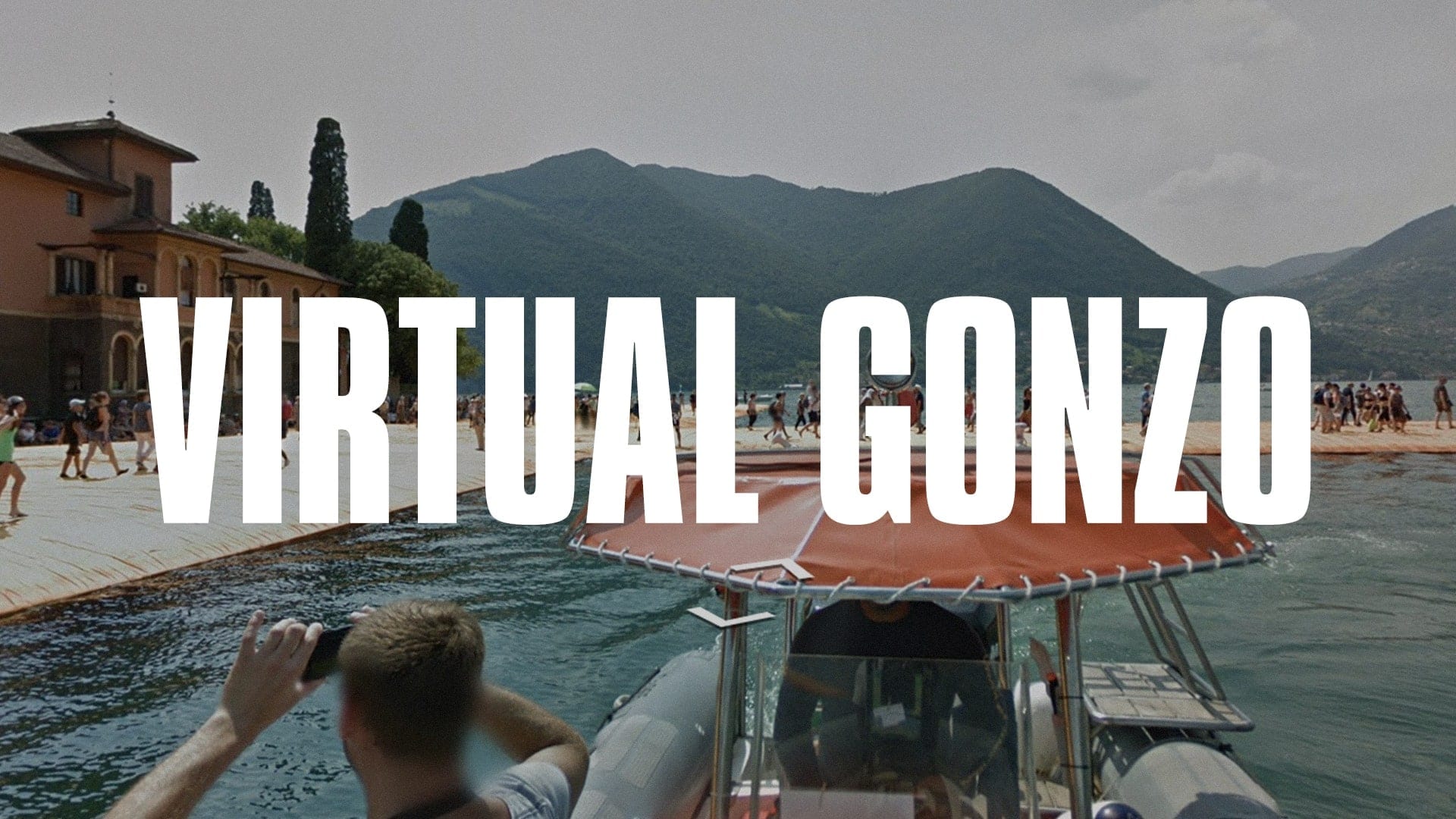

I’m making my way across Lake Iseo in Italy, hovering above Christo and Jeanne-Claude’s ‘Floating Piers’ (2016). Click forward on Google Street View, and I get shuttled along the simmering golden walkway, which stretches miles ahead over the vast indigo sheen of the lake.
Again, click the arrow. Move fractionally towards the mountains. ‘Virtual Gonzo’ comes into my head as a possible title for this piece. I google the phrase, then turn to writing this sentence, before checking the results: a virtual reality money slot. An image from a book showing a technician puppeteering the character Gonzo on a blocky computer. A screenshot of a floating voyeur caught in the air above a beach on Second Life. I take my own screenshot. Then return to my own voyeuristic, virtual floating.
I’m thinking about the gap between labour and leisure — bleary at the best of times, when you’re a writer
Back on the ‘Floating Piers’ tab, I wonder if I’ll ever catch up with the group of four people walking in front of me. They’ve been matching the pace of the Street View camera for a while now. The guy in the pink T-shirt is dominant, at least conversationally. In this frame, he gesticulates, and I imagine he’s saying, ‘This project took €15 million to build.’ Now he’s pointing to the town of Sulzano — probably, I haven’t checked.
I move across the walkway — either in first person or third, having become attached to these four strangers as protagonists. As I — or they — progress, as boats cruise in stop-motion on either side of the floating yellow-brick-road, I’m thinking about the gap between labour and leisure — bleary at the best of times, when you’re a writer. If a travel writer has to go on holiday for her work, this is like time out from a staycation, as I sit here on my sofa, writing, clicking. Dark green mountains in the distance.


Could that blurring of labour and leisure, art and life, be part of Christo and Jeanne-Claude’s project in 2016? This massive land art intervention is one that wants to be lived. ‘You need to physically go through it,’ Christo says on the Hyperallergic tab I’ve opened. Do I still live it if I’m not there with the sun’s heat coalescing with the coolness coming off the lake which surrounds me?
If I was there, I might not notice how the walkway’s extreme vanishing point cuts the lake into two neat triangles, which would seem to require a 2-D picture plane. Whose image am I reading now — Christo and Jeanne-Claude’s, Street View’s, or my own screenshot? Is there any point in doing so? If so, what?
The strangers here are doubly anonymous, faces blurred out by Google to protect their identities. Strange to see such ghostliness in such a bright and expansive setting
If I was there, I might feel pleasantly anonymous among a crowd of tourists. But the strangers here are doubly anonymous, faces blurred out by Google to protect their identities. Strange to see such ghostliness in such a bright and expansive setting. Ghosts fit. Jeanne-Claude died in 2009. This is Christo memorialising her — excessively, like the Taj Mahal — and realising an idea they had as a couple in 1970. Google have memorialised the shrine.
Now I’m googling testimonials, so I can imagine myself more effectively into the scene. One person describes how the floating floor dips underfoot, making it hard to walk. I consider that as I rush-halt forward in regular intervals with each click.


Jeff MacGregor, on the Smithsonian’s website, says, “The lake is impossible. The lake is a painting of a lake.” He’s also having a virtual experience of the lake’s stillness, the mountains’ distance, the sun’s pervasiveness — a scene too idyllic to be real — even though he’s there.
I get stuck on screenshotting people taking photos. Zoom in to see the lake and mountains and walkway through a woman’s phone screen. Another woman, further down the path, is photographing me — or Google’s camera. I wonder if it’s the irony of photos-within-photos that I like. Or something else.
Another woman, further down the path, is photographing me — or Google’s camera. I wonder if it’s the irony of photos-within-photos that I like. Or something else
The scenery inspires wanderlust, but it also makes me miss the way life is so frequently mediated by smartphone viewfinders and selfie sticks — hasn’t been much of that in Covid-19 isolation. Or do I find a weird kind of solidarity with the people taking photos, because they aren’t really ‘being there’ either?
Crowds of people, and we’re all moving in the same direction — like a pilgrimage. But where to? Ostensibly, Christo and Jeanne-Claude’s walkways connect two tiny, isolated islands to the mainland, for the first time in history.


Takes a few minutes, and a lot of furious clicking, but in the end, I reach one of these islands. Only Street View won’t let me navigate around it. Instead, I exit this capture and hop into another one whose camera is mounted on a boat that takes you round. People are laid out on the pier. The sun is so bright, you almost think to squint, but don’t. Almost think to turn down your screen’s brightness, but don’t.
You could say Christo and Jeanne-Claude’s ‘Floating Piers’ is an exercise in temporality and nomadism — this structure funneled thousands of tourists to places they might not have otherwise visited, then disappeared that same year. My own little pilgrimage has been less about connecting islands than about the desire for connection with other people.
’The lake is a painting of a lake.’ Floating Piers is a screen grab of Floating Piers
Yes, heat, the physicality of walking, etc. would allow me to experience ‘Floating Piers’ as it was intended. But, the other pilgrims would have, too. How many people have seen the Mona Lisa through a smartphone’s viewfinder? From a place of isolation, I find myself wanting this kind of communal experience — the way others would mediate it for me. In blurred out faces, we find the desire to see a face — lacunae of social possibility. Just out of reach.
‘Floating Piers’ gave visitors the feeling they were walking on water. Even that impossible experience was mediated by 200,000 cubes of high-density polyethylene covered in bright yellow fabric. I might not have walked on water. But isn’t there something if not miraculous then revelatory about the fact I can ‘walk’ with people ‘walking on water’? The fact I can experience life in quotation marks as a virtual nomad four years too late for the pilgrimage? ’The lake is a painting of a lake.’ Floating Piers is a screen grab of Floating Piers.




